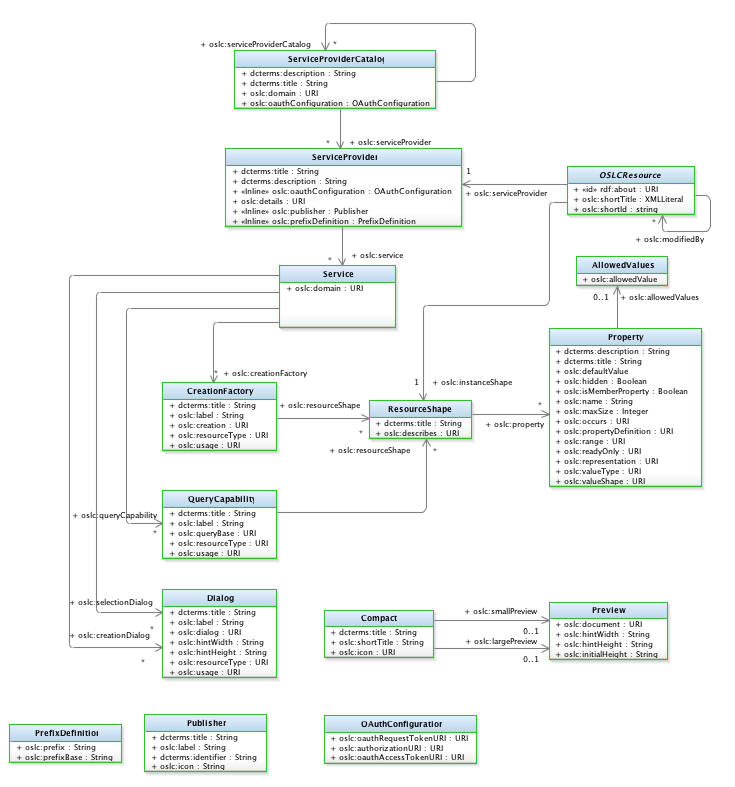Basic Concepts
The following sections introduce the basic concepts of OSLC discovery including how clients find discovery URIs, different approaches clients might use to discover server capabilities, and how server capabilities might be extended.
Bootstrapping Discovery
Discovery will always have to start with at least one discovery resource URI to bootstrap discovery on that server. Servers must provide some way for clients to learn about, find, or discover such LDPC URIs. For example, servers could provide such information:
- In their user documentation or UI
-
Using HTTP
OPTIONS *to return a ServiceProviderCatalog or link headers to root LDPCs describing the discovery capabilities offered
The URI could be for a ServiceProviderCatalog or context LDPC resource on which either static up-front or dynamic incremental discovery can be performed. Different server implementation architectures and extensibility mechanisms may require different approaches for discovering OSLC discovery resource URIs.
This specification specifies how servers respond to discovery requests through LDPC Link headers or ServiceProviderCatalog and/or ServiceProvider resources. It does not specify how servers organize their LDPCs, how they make distinguished LDPCs known to end users to start the discovery process, or how servers provide efficient access to discovery information that may be distributed over many LDPCs managed by the server. Servers may choose to support the OSLC Query capability on OSLC LDPCs and discovery resources in order to facilitate access to discovery information.
Approaches to Discovery
There are various approaches for how servers define and advertise their capabilities, and how clients can efficiently discover what is available. The following sections will provide guidance on approaches that should be used.
OSLC defines two broad approaches for clients to discover capabilities provided by a server, loosely categorized as "Static Up-Front" and "Dynamic Incremental".
Static Up-Front discovery, which is compatible with [[!OSLCCore2]], is an up-front or somewhat more static approach to discovery that utilizes ServiceProviderCatalog, ServiceProvider, and Service resources. Typically a client would perform discovery on startup by accessing the Services defined by any ServiceProvider resources the client might need. A client could also access one or more ServiceProviderCatalog resources in order to locate the available ServiceProvider resources. The client would then configure its capabilities based on what was discovered. In many, or possibly most instances, the ServiceProvider resources will be dynamically created by servers based on the state of the information they manage. Clients may choose to periodically refresh their capabilities by re-reading the ServiceProviders and adapting to the newly available services. Therefore this approach to discovery is not completely static, or up-front, but that does represent a possible common usage pattern.
Figure illustrates the Service Provider Catalog and Service Provider concepts and relationships. There are two resources defined: Service Provider Catalog and Service Provider, that provide the discovery information. There are also a set of local in-line resources that are provided inside these resources to define namespaces, OAuth configurations, contributors as well as services and their capabilities.
To allow clients to discover the RDF vocabularies supported by a server, those vocabularies should be
referenced from the service discovery documents, and the vocabularies themselves and their constraining
ResourceShapes should be readable RDF resources. The oslc:domain property references a namespace
that should resolve to the vocabulary document.

Dynamic Incremental discovery is a second approach that utilizes lazy or deferred discovery, getting
just the information that is needed for any client capability when it is needed, and not getting information
about server capabilities that might not ever be used. Clients typically utilize HTTP OPTIONS or
HEAD methods on LDPCs and get discovery information from Link headers included in the HTTP
response. This approach is more applicable for situations where the services provided by a server are changing
rapidly as the result of resource creation or update, and clients will need to do incremental discovery before
executing the next operations. This approach is also useful for clients that only need to do very specific
things and are not necessarily involved in a long-running conversation with a server. Discovery in this case
can be a simple HTTP OPTIONS request on the required LDPC and the client can immediately complete
its operation without needing to deal with potentially large discovery documents.
Both of these approaches are based on a uniform discovery capability. ServiceProviderCatalog, ServiceProvider and Service resources from [[!OSLCCore2]] are specific kinds of LDP Containers. The members of a ServiceProviderCatalog resource include ServiceProviderCatalogs and ServiceProvider LDPCs. ServiceProvider resource members include Service LDPCs. Each of these LDPCs have additional properties as defined by the OSLC vocabulary and shapes. This allows clients to use either approach to discover server provided OSLC capabilities, and maintains compatibility with [[!OSLCCore2]] while providing new, simple and flexible approaches to service discovery.
Updating Discovery Information
Servers may chose to support changes to their configurations in order to support adding new domains and services, extending existing domains and services, and/or integrating domains. This specification does not specify how servers provide extensibility mechanisms. Some possible approaches could include:
- Configuration information could be provided through files that are read at startup to define the service providers and services for the supported domains. These files could utilize the ServiceProviderCatalog and ServiceProvider resource formats.
-
Servers may provide administration facilities or operational modes (through commands, REST services, GUI,
etc.) that:
- Create and configure additional LDPCs that provide new services
- Define or extend domain vocabularies
- Define or extend resource shapes to constrain vocabularies for specific purposes
- Servers may choose to support these configuration changes only on restart, or dynamically at runtime.
The ServiceProviderCatalog, ServiceProvider and Service shapes specify that much of the discovery information
provided in these resource representations is read-only. Therefore clients accessing these resources cannot
expect to change read-only properties via HTTP PUT operation on the discovery resources as a
means of updating server configurations. However, these constraints only apply to these particular discovery
resource representations and do not prevent servers from providing other means of modifying their
configuration information. These modifications would then be reflected in read-only properties in the
discovery resource representations when they are accessed.